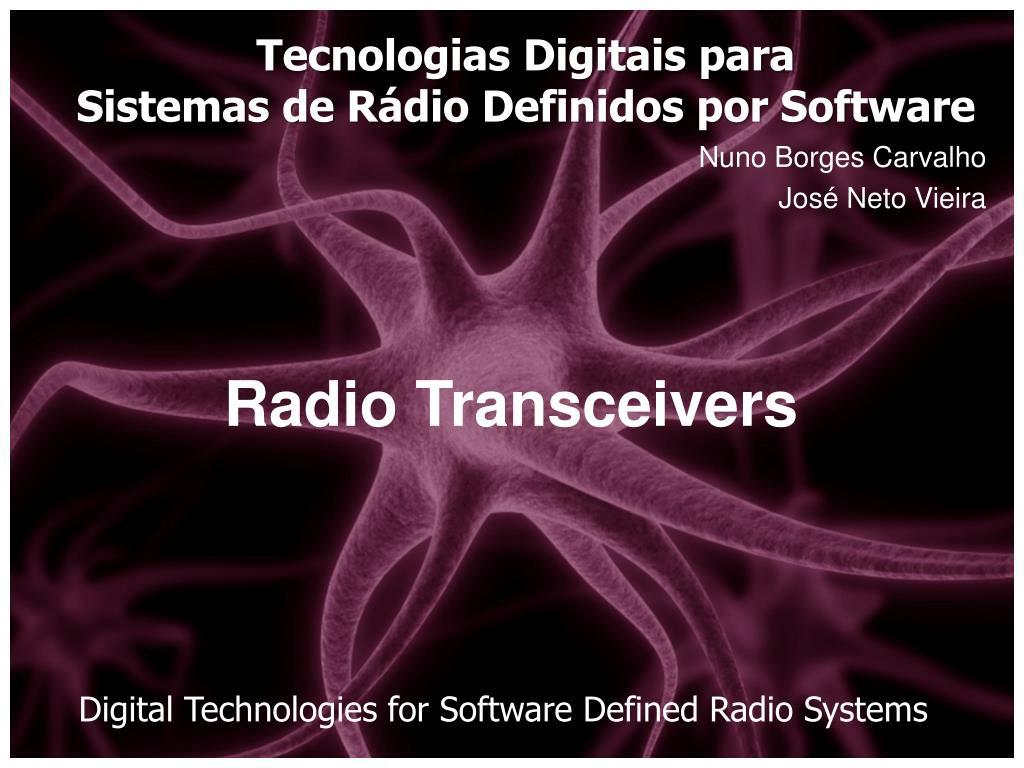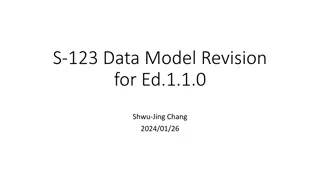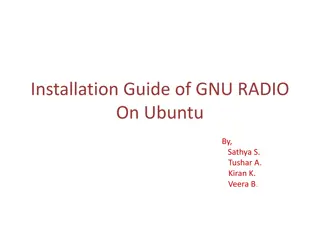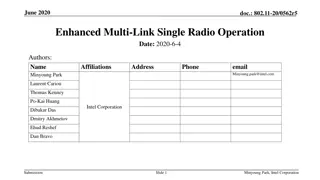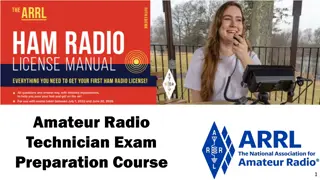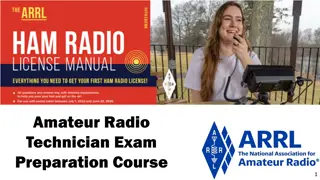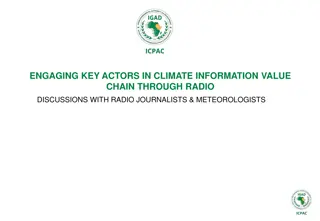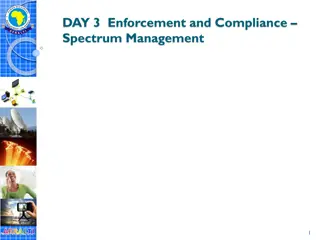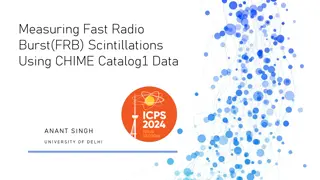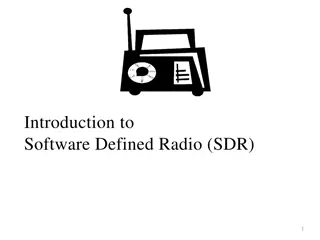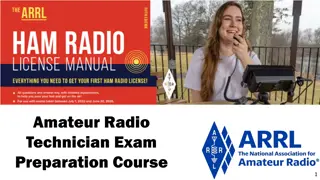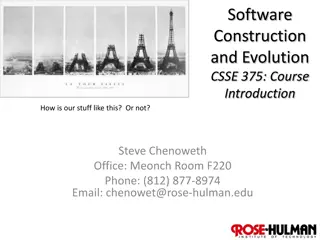Evolution of Software Defined Radio Systems
Software Defined Radio (SDR) revolutionizes radio communication by implementing traditional hardware components using software on a personal computer. With SDR, modulation techniques, security functions, and waveform requirements can be controlled through software, enabling flexibility and adaptability in radio systems. Joe Mitola's definition emphasizes the digital nature of SDR, where signal processing from baseband to RF is entirely digital. SDR systems have transitioned from analog to digital domains, showcasing advancements in technology from baseband processing to RF signal transmission.
Download Presentation

Please find below an Image/Link to download the presentation.
The content on the website is provided AS IS for your information and personal use only. It may not be sold, licensed, or shared on other websites without obtaining consent from the author. Download presentation by click this link. If you encounter any issues during the download, it is possible that the publisher has removed the file from their server.
E N D
Presentation Transcript
Tecnologias Digitais para Sistemas de R dio Definidos por Software Nuno Borges Carvalho Jos Neto Vieira Radio Transceivers Digital Technologies for Software Defined Radio Systems
Software Defined Radio Analog Radio Conversion made by hardware Filtering and demodulation done with electronic components
Software Defined Radio Software Defined Radio Radio in which the processing is completelly digital. Joe Mitola says, "A software radio is a radio whose channel modulation waveforms are defined in software. That is, waveforms are generated as sampled digital signals, converted from digital to analog via a wideband DAC and then possibly upconverted from IF to RF. The receiver, similarly, employs a wideband Analog to Digital Converter (ADC) that captures all of the channels of the software radio node. The receiver then extracts, downconverts and demodulates the channel waveform using software on a general purpose processor." J. Mitola, The software radio architecture, IEEE Communications Magazine, vol. 33, n 5, pp. 26 38, May 1995
Software Defined Radio A Software Defined Radio (SDR) system is a radio communication system where components that have typically been implemented in hardware (i.e. mixers, filters, amplifiers, modulators/demodulators, detectors. etc.) are implemented using software on a personal computer. Definition by SDR Forum- Software defined radio is used to describe radios that provide software control of a variety of modulation techniques, wide-band or communications security functions (such as hopping), and waveform requirements of current and evolving standards over a broad frequency range. narrow-band operation,
Software Defined Radio Actual SDR systems . Some parts in the analog domain, some parts in the digital domain.
Software Defined Radio SDR has been conquering the analog world, moving from base band to RF. RF IF Baseband Antenna Bandpass Filter ADC/DAC DSP Variable Frequency Oscillator Local Oscillator
Software Defined Radio SDR has been conquering the analog world, moving from base band to RF. RF IF Baseband Antenna All Digital ADC/DAC DSP Variable Frequency Oscillator
Software Defined Radio SDR has been conquering the analog world, moving from base band to RF. RF IF Baseband Antenna All Digital All Digital ADC/DAC DSP
Software Defined Radio Dynamic range is nothing more that the difference between the minimum and the maximum power the transceiver (receiver) can dealt with. = DR max P iS , min Where Pmax is normally calculated as the maximum power that will saturate the receiver front end, so that the auto-generated nonlinear distortion is similar to the seek SNR.
Software Defined Radio . Problems associated with large signal variations, mainly dynamic range limitations. ( ) t 2 max x = 0 t NT PAPR NT 0 2 1 ( ) NT x t dt 10 10 8 8 6 6 4 4 Amplitude Amplitude 2 2 0 0 -2 -2 -4 -4 -6 -6 -8 -8 -10 -10 0 500 1000 1500 2000 2500 3000 3500 4000 0 500 1000 1500 2000 2500 3000 3500 4000 time time
Software Defined Radio . At the transmitter PAPR can degrade Digital to Analog Converters DAC Power Amplifiers ... ... 101011 Processing Unit Tx - Base Band 0 90 At Receiver ... ... 110101 Analog to Digital Converter ... ... 101011 Processing Unit Rx - Base Band AGC Control Power Detector 0 90 ... ... 110101
Software Defined Radio Several configurations can be used for ADC s: Flash ADC Delta-tracking, uses DAC s Ramp-compare ADC; Sigma-Delta . Pipeline
Software Defined Radio . Ideal transmitter in SDR: PWM modulator, digital signals goes till the antenna: Class S Amplifier BPF Output RF Input
Cognitive Radio . By cognitive we can understand: Original definition by Joseph Mitolla (1999) A radio that employs model based reasoning to achieve a specified level of competence in radio-related domains Simon Haykin s Definition: An ambient-aware, intelligent radio which learn from its surroundings and adapt itself to: Highly reliable communication, anywhere, anytime; Efficient use of Radio Spectrum;
CR PBAR . SR Increasing Flexibility and Hardware radio includes firmware and therefore may have significant operational flexibility. Reconfigurability Ideal Software Radio SDR SCR + SDR baseband + SDR RF SCR + SDR baseband (for some applications) SCR Hardware Radio 1995 2005 2015 2025 1995: First RFI on SDR 2004: First SDR device approved by FCC Note: SDR currently is practical for some applications such as commercial wireless basestations, but not for some wireless handsets. Cost, power, size and weight are critical design requirements that must be considered when considering the use of advanced radio technologies. CR Cognitive Radio RFI Request for Information SDR Software Defined Radio PBAR Policy-Based Adaptive Radio SCR Software Controlled Radio SR Software Radio IEEE 1900 Committee
Cognitive Radio . RF Resource Request RF Transmit Plan Bound: Yes/No Unbound: Binding Constraints
Cognitive Radio Non Cognitive Radios: Transmitter and Receiver Data Modem Antenna Coupling Processor Networked Device Cognitive Radios: Spectrum Scanning and Interference Avoidance Module Channel Pooling Server Spectrum Analysis Engine Scanning Engine Antenna Sharing Module Transmitter Transmitter and Receiver and Receiver Processor Processor Data Modem Data Modem Networked Device Wireless Data Transceiver Subsystem Module
Cognitive Radio In a cognitive radio we should be able to: Create our own waveforms, Negotiate different interfaces Maintain QoS be managing is radio Practically it should be: SDR + Have some kind of intelligence Environment aware Be capable of sensing the environment
Cognitive Radio Infer from Context Cognition cycle Orient Establish Priority Infer from Radio Model [Mitola_99] Normal Pre-process Select Alternate Plan Goals Parse Stimuli Urgent Immediate Learn Observe New States Decide States User Driven (Buttons) Generate Best Waveform Autonomous Act Outside World Allocate Resources Initiate Processes Negotiate Protocols
